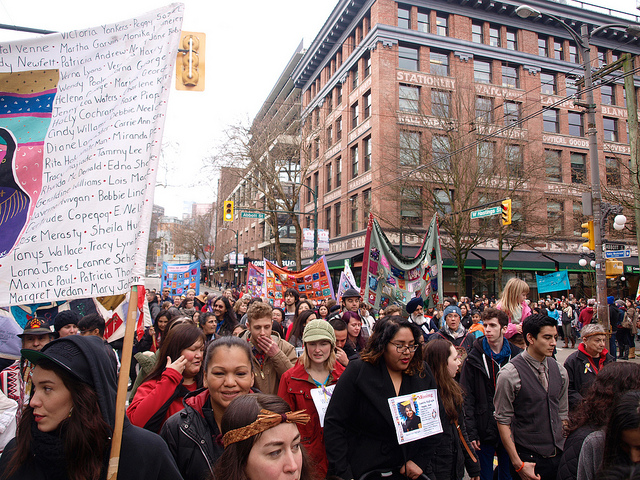Former VPD detective on the infamous Pickton case opens up on how we did the missing women wrong, and the reports that stay an unsolved mystery
By Kristi Alexandra
@kristialexandra
It was April 14, 1998, when Sarah de Vries was reported missing. Her DNA would be found years later on infamous serial killer Robert “Willie” Pickton’s farm. Though the man boasted to an undercover cop he had killed as many as 49 women, he was convicted of second-degree murder of only six. De Vries wasn’t one of them.
The 28-year-old woman was known on Vancouver’s Downtown Eastside for being the bubbly girl that took other young sex workers under her wing. She was first pulled to the DTES — with its crowds and drugs and all-night lifestyle — during her teens. De Vries was an adopted woman of colour to a wealthy, caucasian family from Point Grey.
She was drawn to the veritable mesh of “outsiders” in Canada’s poorest postal code. Among outsiders is where she came to belong.
Across Canada, as little as 1,200 women are currently missing or murdered. That number represents only those cases that have been reported, while several more go unsolved or unreported.
Between 1980 and 2014, police services across Canada reported a total of 6,849 homicides involving female victims.

OPENING THE COLD CASE
A few months after Sarah de Vries’ disappearance, detective Lori Shenher—now known as Lorimer—was put on the missing persons beat at Vancouver Police Department. That year, the number of women going missing from the Downtown Eastside was at an unusual high. De Vries was his first case.
“Nobody wanted the Missing Persons job, but I thought that was cool. I was intrigued by these true mysteries,” says Shenher, who released his novel telling all about the chilling Pickton case called That Lonely Section of Hell in late 2015.
“There were 17 missing women when I took the job—all paper files. I begged for a computer to enter the information and start analysing it.”
Shenher’s first task was to pick through each file and see how much work had — or hadn’t — been done: talking to people in their lives, finding out where they last lived, going through their personal effects if they were still around.
“They were really cold trails which made it hard,” he admits.
“They had a lot of problems like… they weren’t in touch with their families and it took a long time for people to think they were missing. They’d call-in in December and they’d say, ‘The last time I talked to her was March.’”
Some files were quite thorough; others weren’t. Some of that was because the victims were hard to track down; others because the work just wasn’t done.
“I felt really horrified. I don’t think it was a lack of caring… it was a perfect storm of not enough resources, people going off sick, and just generally not being around,” Shenher reveals.
According to the National Missing Persons Coordination Centre, approximately one-third of missing persons go missing more than once.
“The more times [a woman] goes missing, it increases her risk of being a victim,” Shenher says, explaining it was the opinion of some that some missing people don’t want to be found.
“It’s not good enough to say ‘she’s probably hiding from this guy.’ Who is this guy and why is she scared?”
THE WOMEN VERSUS ‘THE GUY’
On Shenher’s second day at the Missing Person’s desk, he got a call on the Crimestoppers tip-line about a man named “Willie” Pickton.
“This guy phoned in, and he said ‘[“Willie” Pickton] lives in Coquitlam, he has a farm, I think he’s responsible for the missing women. He has bloody clothing and bags out there; he has a grinder.’”
Shenher looked up a file on Robert “Willie” Pickton. He found two stayed charges of attempted murder and forcible confinement. He was known to sex workers on the Downtown Eastside as a “bad date.”
“It was like ‘Bingo! This guy has done this before.’ This was our guy.”
At that time, there were 17 women missing from the Downtown Eastside. Sparely detailed missing persons reports made it difficult for Shenher to track them down. Later, as many as 31 women were identified as missing, and 27 of them would be confirmed dead.
“You start to see the systemic biases coming into place: this is an adult, this is woman who doesn’t want to be found, this someone who puts herself in harm’s way by standing on the street. All these biases and sexist constructs come into play,” he says of the files.
From February 2002 to May 2005, Pickton was charged with the murders of Sereena Abotsway, Mona Wilson, Jacqueline McDonell, Diane Rock, Heather Bottomley, Andrea Joesbury, Brenda Wolfe, Georgina Papin, Patricia Johnson, Helen Hallmark, Jennifer Furminger, Heather Chinnock, Tanya Holyk, Sherry Irving, Inga Hall, Cara Ellis, Andrea Borhaven, Debra Lynne Jones, Marnie Frey, Tiffany Drew, Kerry Koski, Sarah de Vries, Cynthia Feliks, Angela Jardine, Wendy Crawford, Diana Melnick, and an unidentifiable woman—a total of 27 murder charges.
He was convicted of only six.
According to an excerpt from “Well-Being in the Urban Aboriginal Community” by Patricia O’Reilly and Thomas Fleming, not all of Robert Pickton’s victims were Aboriginal, but over half were of Indigenous ancestry.
WHAT WENT WRONG?
Because the case was crossing into new territory, the Vancouver Police Department handed some responsibilities over to the Coquitlam RCMP — namely, to execute a search warrant. That didn’t happen until 2002: four years after Shenher was tipped off about the farm owner.
By that time, Shenher had left the case, having started to burn out and develop post-traumatic stress disorder.
“It started to be clear to me that nothing was happening. I was so burned out and so demoralized. There was a part of me that thought ‘If I leave, maybe a change would help.’”
At the VPD’s case’s height, there were 31 missing women from the DTES. Four of them were found alive.
“From summer of ‘99 to February 2002, I don’t know how many women died in that time,” Shenher says. “Those are the ones that haunt me.”
In Canadian media, the reported number of missing and murdered women ranges from 500 to 1,200. Shenher explains why that number varies so erratically.
“We’ve never been able to nail down numbers, which is a really huge problem. Across the country, they haven’t even been able to nail down numbers. Some of them have never been reported missing: either their families haven’t, or they haven’t trusted the police, or they haven’t found a body. There are all these stories, so to get an accurate number is really hard,” he says.

THE MISSING WOMEN’S INQUIRY: A TIME TO HEAL
With such ambiguous figures, it’s hard to put a stop to the pattern of women going missing, let alone honour their individual identities.
In December 2015, the Liberal Government of Canada announced the launch of a two-phase national inquiry to address the high number of missing and murdered women and girls.
“[The] inquiry into missing and murdered Indigenous women and girls can only be designed after hearing from those directly affected. We are committed to an inclusive and respectful engagement process which incorporates the viewpoints and perspectives of those impacted by this national tragedy,” said justice minister Jody Wilson-Raybould.
Wayne Leng, a concerned citizen who worked around the Downtown Eastside, set up a webpage and 1-800 tip line dedicated to finding the missing women at the time.
His website Missingpeople.net continues to recognize the women as they were – with poems and stories and open letters penned by their friends and families – before they were known simply as Pickton’s victims.
Last updated on February 15, the government of Canada said it would be announcing details of a national inquiry into missing women across Canada.
The February press release reads, “We are determined to do this right for the survivors, families, and loved ones. To honour the spirits and memories of those we have lost and to protect future generations.”

Kristi Alexandra is an unabashed wino and wannabe musician. Her talents include drinking an entire bottle of cabernet sauvignon, singing in the bathtub, and falling asleep.

Artist: Chelsea is a marketer by day and an artist by night. She loves painting, drawing, beer tasting, and cooking for other people. Check out her artwork at www.chelsealawrickart.com



